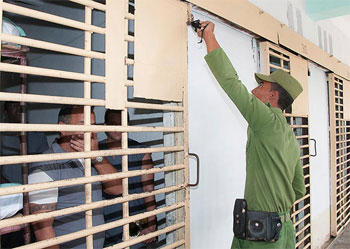Cuba’s Prisons Visited by Foreign Press

HAVANA TIMES — For the first time in a decade, the Cuban government authorized the foreign press access to several detention centers, allowing two busloads of journalists to visit four prisons.
The authorities intend to show to the world the results of a less strict system in which half of the prisoners enjoy an “open system” that allows them to work beyond the bars and to visit their families.
In Cuba, there are 57,000 prisoners divided into five maximum security prisons, 40 standard ones and 155 open facilities. One of the latter is La Lima, whose director, Major Jorge Fonseca, told the audience that half of all inmates today benefit from less stringent system, though the national plan over the coming years is to have “70 percent of inmates in the open system.”
In the Combinado del Este are found the most dangerous prisoners in Havana, many of them aren’t even allowed to work. This institution has the lowest rate of labor participation in the country (only 27 percent) while the national average is over 40 percent. However, there also exists a system of awards for good behavior, and inmate participate in rehabilitation programs that open doors for them to work, study, learn a trade, and even reduce their sentences and give them the possibility of being moved to a more open regime.
In prison there are schools for learning skills. They can even work in a yard full of junked cars. Engineer Rafael Farsa explained: “About 25 cars come into the prison each week. From these are collected parts valued at $1 million (USD) annually.”

Though inmates earn a salary of around $20 per month, there are stronger incentives to work, ones that include increased numbers of conjugal visits, reductions on sentences of up to four months per year, and movement into more open forms of detention.
Apparently this incentive system is reducing the level of violence among inmates. “This will never be a good atmosphere but there’s no violence,” confirms Daniel Acuña, an inmate who has served 25 years on charges of burglary (we found him playing baseball). He explained to us that “there’s no sexual violence.” Similarly, there are currently less than six stabbing injuries a year, said hospital prison head Dr. Mariano Izquierdo.
He added that the incidence of HIV/AIDS was lower because carriers are in a special institution, preventing them from the spreading the virus. What’s more, all inmates are tested annually and anti-retroviral treatments are given to those who are 0 positive.
“I get everything I need for my disease, and now I’m being considered for breast surgery,” said female inmate and patient Lianes Lamonth, who was diagnosed as a carrier when entering prison and then taken to the special San Jose facility on the outskirts of Havana.
Inmates don’t complain much about the living conditions at Combinado, but several of those interviewed did protest about long waits for trial and the harshness of the sentences.

Cuban laws put no time limit on a person’s indictment. In the waiting room, Enriquez Delia therefore described how her husband has already spent two years in prison without his ever being convicted of a crime. “He was accused of receiving stolen property, but he’s still waiting for the prosecutor to file charges.”
The visit itself wasn’t without protests. One of the inmates shouted, “Here they violate all the rights of prisoners. They might as well send me to the military base at Guantanamo Bay, where they have all the ‘bad guys’ –but they don’t torture anybody.”
Meanwhile Colombian national Rafael Bustamante (convicted of international drug trafficking) and Italian Simone Fini, (charged with murdering a Cuban teenager) shouted from their cells that they were innocent and were “kidnapped by the dictatorship.”
Open prisons
In recent years the number of minimum-security open prisons has increased. Inmates can be transferred into these based on merit demonstrated during their stays in other penal institutions or because their offense is minor and the prisoner poses no danger to society, explained Mayor Jorge Fonseca, head of the La Lima open detention center.
In these are concentrated inmates for economic crimes and corruption, which are common these days given the cleanup campaign promoted by the government. There are more than 100 prisoners in La Lima serving sentences for economic crimes. Jesus Quintero, 60, confessed to us that he was convicted of “embezzling $250,000 (USD) while working for a foreign company.”

At these centers, work is external, with prisoners employed mainly on housing construction and city clean-up crews. They come and go to work without police escorts, while prison security overall is minimal and prisoners can visit their families once a month for 72 hours. If they don’t return, they’re later sent back to closed prisons.
The inmates can join work-study programs in order to finish their sentences with a trade for making a living. In any case, all of those released come out with a job in a state enterprise thanks to a national agreement. There’s also a “multidisciplinary team” that coordinates actions with the family so they have positive influences on the detainees.
When Raul Castro took office in 2007, prison policy began to change. The government promoted the creation of dozens of these open prisons across the country in order to transfer non-threatening prisoners to less strict conditions.
In 2010 the release of 250 political prisoners was ordered following an agreement mediated by the Spanish government and the Catholic Church. A year later, amnesties were given to 3,000 common prisoners and it was announced that each year similar actions would be repeated for those who no longer presented a danger to society.
Most recently, death sentences were commuted for all those on death row.
—
An authorized translation by Havana Times (from the Spanish original) published by Cartas Desde Cuba.





